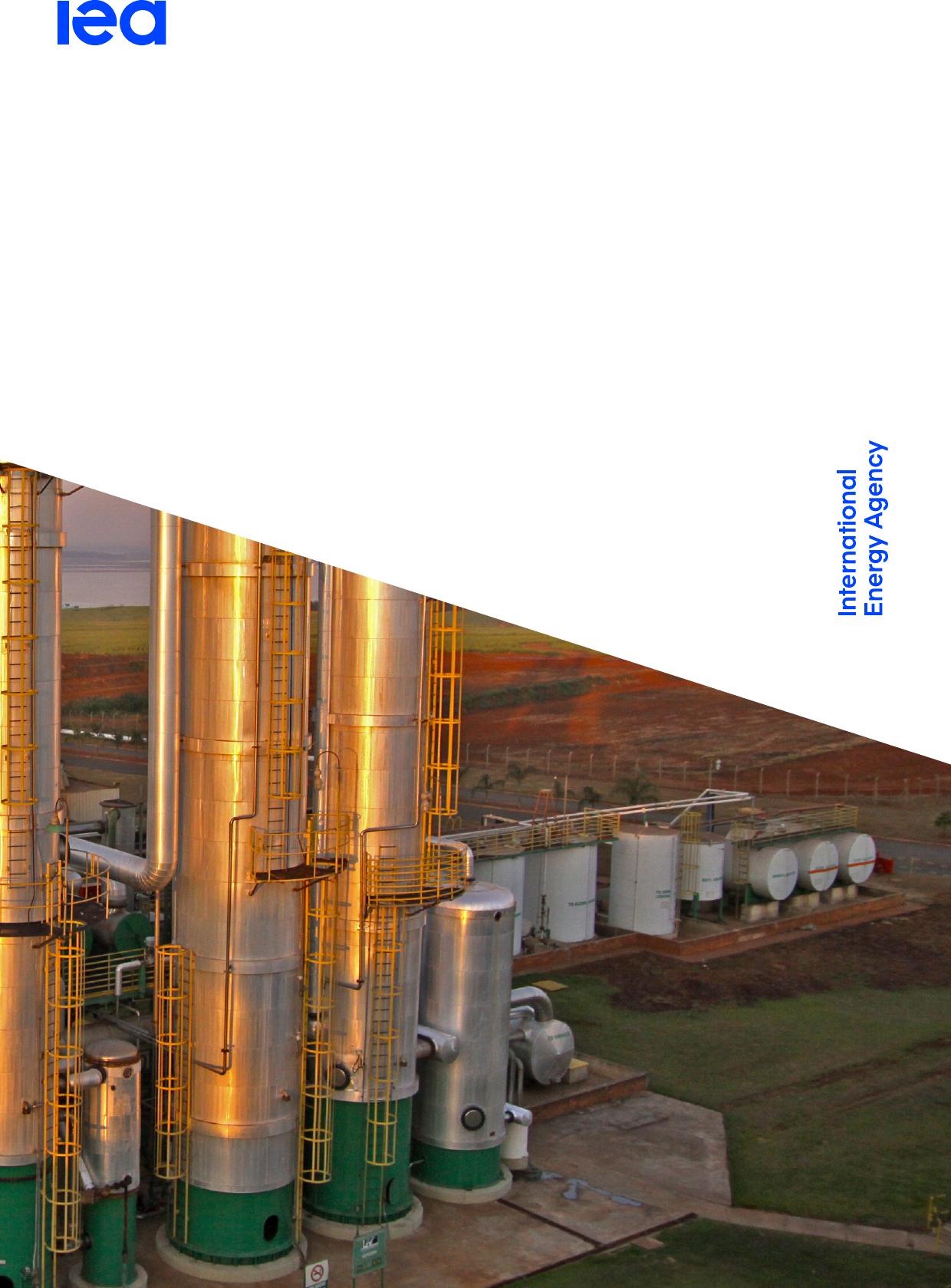BiofuelPolicyinBrazil,IndiaandtheUnitedStatesInsightsfortheGlobalBiofuelAlliance更多报告请关注星球:碳通通TheIEAexaminesthefullspectrumofenergyissuesincludingoil,gasandcoalsupplyanddemand,renewableenergytechnologies,electricitymarkets,energyefficiency,accesstoenergy,demandsidemanagementandmuchmore.Throughitswork,theIEAadvocatespoliciesthatwillenhancethereliability,affordabilityandsustainabilityofenergyinits31membercountries,13associationcountriesandbeyond.Thispublicationandanymapincludedhereinarewithoutprejudicetothestatusoforsovereigntyoveranyterritory,tothedelimitationofinternationalfrontiersandboundariesandtothenameofanyterritory,cityorarea.Source:IEA.InternationalEnergyAgencyWebsite:www.iea.orgIEAmembercountries:AustraliaAustriaBelgiumCanadaCzechRepublicDenmarkEstoniaFinlandFranceGermanyGreeceHungaryIrelandItalyJapanKoreaLithuaniaLuxembourgMexicoNetherlandsNewZealandNorwayPolandPortugalSlovakRepublicSpainSwedenSwitzerlandRepublicofTürkiyeUnitedKingdomUnitedStatesTheEuropeanCommissionalsoparticipatesintheworkoftheIEAIEAassociationcountries:ArgentinaBrazilChinaEgyptIndiaIndonesiaKenyaMoroccoSenegalSingaporeSouthAfricaThailandUkraineINTERNATIONALENERGYAGENCYBiofuelPolicyinBrazil,IndiaandtheUnitedStatesAbstractInsightsfortheGlobalBiofuelAlliancePAGE3AbstractAspartofitsG20presidency,IndiahasproposedaGlobalBiofuelAlliance(GBA)tobringcountriestogethertoexpandandcreatenewmarketsforsustainablebiofuels.Thesharingofbestpractices,thetechnicalsupportandthecapacitybuildingthattheGBAwouldbringarewelcomeadditionstointernationaleffortstoexpandsustainablebiofuelproductionanduse,akeysteptodecarbonisingtransportationandheatserviceswithsecureandaffordableenergysupplies.ThisreportaimstoinformandfocustheAlliance’sworkbysharingbiofuelpolicyinsightsfromBrazil,IndiaandtheUnitedStates.Wefindthatthesecountrieshaveexpandedbiofuelproductionandusebydesigninglong-termstrategies,implementingtherightinvestmentsignals,supportinginnovation,ensuringsuppliesaresecureandaffordable,addressingsustainabilityconcernsearlyandcollaboratingwiththeinternationalcommunity.Further,therearethreepriorityareasthatwouldfacilitatesustainablebiofueldeploymentinsupportoftheglobalenergytransition:Identifyingandhelpingdevelopmarketswithhighpotentialforsustainablebiofuelsproduction,acceleratingtechnologydeploymentandseekingconsensusonperformance-basedsustainabilityassessmentsandframeworks.更多报告请关注星球:碳通通BiofuelPolicyinBrazil,IndiaandtheUnitedStatesAcknowledgementsInsightsfortheGlobalBiofuelAlliancePAGE4Acknowledgements,contributorsandcreditsThisstudywaspreparedbytheRenewableEnergyDivisionincollaborationwithmembersoftheBiofuturePlatform,aCleanEnergyMinisterialInitiative.ThestudywasconceivedanddirectedbyPaoloFrankl,HeadoftheRenewableEnergyDivision.Thedesign,analysisandproductionofthereportwereledandcoordinatedbyJeremyMoorhouse,BioenergyAnalystintheRenewableEnergyDivision.Valuablecomments,feedbackandguidancewereprovidedbyKeisukeSadamori,DirectorofEnergyMarketsandSecurityandTorilBosoni,HeadofOilIndustryandMarketsDivision.WealsothankPraveenBains,AnaAlcandeBascones,HanaChambers,AlejandraBernal-Guzman,AsthaGupta(Consultant),JoergHusar,andKavitaJadhav.MembersoftheBiofuturePlatformincludingJimSpaeth(DOE–BioenergyTechnologiesOfficeSystemDevelopmentandIntegrationProgramManager/ChairBiofuturePlatformInitiative),KeithKlein(OakRidgeNationalLaboratory–DistinguishedScientist),GerarldOstheimer(ManageroftheCleanEnergyMinisterialBiofutureCampaign),AndreaRossi(IEABioenergyTCP–Secretary)andAdamBrown(EnergyInsightsLtd.–ManagingDirector)madeimportantcontributions.ThisworkbenefitedfromreviewandcontributionsfromLaísdeSouzaGarcia(MinistryofExternalRelations,Brazil–HeadoftheRenewableEnergyDivision),MarlonArraesJardimLeal(MinistryofMinesandEnergy,Brazil–DirectorofBiofuelsDepartment),GeorgeThomas(MinistryofPetroleumandNaturalGas,India–DirectorInternationalCooperationDivision).TheauthorswouldalsoliketothankGregoryViscusiforeditingthereportandtheIEACommunicationandDigitalOffice,inparticularAstridDumond.ThispolicyinsightpaperwasdevelopedinclosecollaborationwithmembersoftheBiofuturePlatform,aCleanEnergyMinisterialInitiative,forwhichtheIEAactsasfacilitator.BiofuelPolicyinBrazil,IndiaandtheUnitedStatesTableofcontentsInsightsfortheGlobalBiofuelAlliancePAGE5TableofcontentsExecutivesummary.................................................................................................................6Introduction.............................................................................................................................8Sustainablebiofuelproductionmusttripleby2030onanetzerotrajectory.............................8Bothconventionalandadvancedfuelsexpand.........................................................................9Learningfrompolicyimplementationcanhelpexpandsustainablesupplies..........................10Expandingsustainablefeedstocksupplyanddevelopingnewmarketsrequiresparticularattention....................................................................................................................................11Brazil.....................................................................................................................................13UnitedStates.........................................................................................................................17India.......................................................................................................................................21Lessonslearned....................................................................................................................25ImplicationsfortheGlobalBiofuelAlliance..........................................................................27更多报告请关注星球:碳通通BiofuelPolicyinBrazil,IndiaandtheUnitedStatesExecutivesummaryInsightsfortheGlobalBiofuelAlliancePAGE6ExecutivesummaryIndiahasproposedaGlobalBiofuelAlliancethataimstosupportworldwidedevelopmentanddeploymentofsustainablebiofuels.TheGlobalBiofuelAlliance(GBA)aimstoestablishaglobalpartnershipofnationalgovernments,agencies,industriesandotherstakeholderstoadvancesustainablebiofuelstechnologydeploymentandexpandsustainablebiofuelsmarketpenetration.TheGBArecognisesthatsustainablebiofuelsareapillaroftheglobalenergytransition.TheGBA’sgovernanceframeworkandactionplanwillbedevelopedoverthecomingmonths.Biofuelsoffernumerousadvantages.Liquidbiofuelsin2022avoidednear2millionbarrelsofoilperdayinthetransportsector,over4%ofglobaltransportdemand,helpingsecureenergysuppliesduringtheenergycrisis.Biofuelsarealsocompatiblewithexistinginfrastructure,canbemadeusingwastesandresiduesandoffereconomicandemploymentopportunitiesforruralcommunities.Sustainablebiofuelproductionisnotontrackforanetzerotrajectory:Globalbiofuelgrowththrough2028isrunningatlessthanhalftherateneededtohelpachievenetzeroemissionsbymid-centurybasedoncurrentpoliciesandmarkettrends.IntheIEA’sNetZeroEmissionsby2050(NZE)Scenario,sustainablebiofuelproductionneedstotripleby2030tohelpreduceemissionsfromnewandexistingtrucks,planes,shipsandpassengervehiclesthathavefewothermitigationoptions.Over80%ofglobalproductionisconcentratedinjustfourmarkets:theUnitedStates,Brazil,EuropeandIndonesia.Thesemarketsaccountforonlyhalfofglobaltransportfueldemand.Thisshareisforecasttodeclinetonear40%by2028.Expandingsustainablebiofuelswillthereforerequiredevelopingnewmarketsandhigheruseinexistingones.Brazil,IndiaandtheUnitedStatesshowcasepoliciesthathavedrivenconsiderablegrowthinsupply.Brazil,IndiaandtheUnitedStateshavedeployedpolicieswhichsustainedannualgrowthratesabove20%overatleastafive-yearperiod.Asaresult,biofuelsprovided22%ofBrazil’sand7%oftheUnitedStatestransportenergyin2022.InIndia,ethanol’sshareofenergyuseingasolinevehiclesreached6%in2022,double2019levels.Sixpolicypillarshavesupportedbiofuelgrowth:Brazil,IndiaandtheUnitedStateshaveexpandedbiofuelproductionandusebydesigninglong-termstrategies,implementingtherightinvestmentsignals,supportinginnovation,ensuringsuppliesaresecureandaffordable,addressingsustainabilityconcernsearlyandcollaboratingwiththeinternationalcommunity.BiofuelPolicyinBrazil,IndiaandtheUnitedStatesExecutivesummaryInsightsfortheGlobalBiofuelAlliancePAGE7Sustainablefeedstocksuppliesaresufficienttotriplebiofuelsproductionby2030.Advancedbiofuelsmadefromorganicwastesandresidues,forinstance,couldsupportanadditional2.4mboe/dby2030,morethantotalbiofuelproductionin2022.Thislevelofgrowthrequiresafifteen-foldincreaseinadvancedbiofueldeployment.ConventionalbiofuelsalsoexpandintheIEA’sNZEScenario,buttoalesserextent,withnonetincreaseincroplanduseforbiofuelsandnobiofuelcropsonexistingforestedland.Themixofadvancedandconventionalfuelswillvarywitheachcountry.Moretechnologydevelopmentandinnovationeffortsareneededtoexpandsustainablefeedstocks.ThescaleandpaceofgrowthintheIEA’sNZEScenariorequires:1)Enhancinglandproductivitytomakethemostofexistingcroplandandmarginalland2)Improvingwasteandresiduecollectionofthosefeedstockscompatiblewithexistingbiofueltechnologiessuchasresiduevegetableoils3)Deployingtechnologiesthatcanprocessdifferentfeedstockssuchasagriculturalandforestresidues.TheGlobalBiofuelAlliancecanacceleratethedeploymentofsustainable,secureandaffordablebiofuels.Therearethreepriorityareasthatwouldfacilitatesustainablebiofueldeploymentinsupportoftheglobalenergytransition:Identifyandhelpdevelopmarketswithhighpotentialforsustainablebiofuelsproduction:Expandingbiofuelsproductionrequiresdistinguishinghighpotentialregionsinbothexistingandnewmarkets.Growingthesemarketswillalsorequire:Enhancingmeasurementandmonitoringforsustainablesupplies:Forprioritymarkets,developandapplyaconsistentsustainablefeedstockassessment,monitoring,andreportingapproach.Assessingmixedtechnologydevelopmentpathways:Eachprioritymarketwillhaveitsownpotentialforconventionalandadvancedbiofueltechnologies,aswellasgreenhousegas(GHG)reductiontechnologieslikecarboncaptureutilisationandstorage.Developingregional-specificpolicypackageslearningfromexistingexperiences.Brazil,IndiaandtheUnitedStatesofferexamplesofsixpolicypillarsthathaveworkedandcommonchallengesthatcanbeusedtosupportpolicypackagesinnewmarkets.Acceleratetechnologydeploymenttocommercialiseadvancedbiofuels:Coordinated,internationaleffortsarenecessarytocommercialiseadvancedbiofuelsatscale,vitaltorealisingthepotentialofbiofuels.Seekconsensusonperformance-basedsustainabilityassessmentsandframeworks:Moreconsistentandinternationallyrecognisedsustainabilityframeworkswouldhelpimprovemeasurementandreporting,improveGHGreductions,encouragesustainablebiofuelstradeandhelpnewmarketsincorporatelifecycleGHGaccountingintotheirbiofuelpolicies.更多报告请关注知识星球:碳通通BiofuelPolicyinBrazil,IndiaandtheUnitedStatesIntroductionInsightsfortheGlobalBiofuelAlliancePAGE8IntroductionIndiahasproposedaGlobalBiofuelAlliance(GBA)tobringcountriestogethertoexpandandcreatenewmarketsforsustainablebiofuels.Thesharingofbestpractices,thetechnicalsupportandthecapacitybuildingthattheGBAwouldbringarewelcomeadditionstointernationaleffortstoexpandsustainablebiofuelproductionanduse,akeysteptodecarbonisingtransportationandheatserviceswithsecureandaffordableenergysupplies.ThisdocumentaimstoinformandfocustheAlliance’sworkbysharingpolicylessonsfromthreesuccessfulbiofuelcountriesabouttherolesustainablebiofuelscanplayinenergytransitionsinthetransportsector.Sustainablebiofuelproductionmusttripleby2030onanetzerotrajectoryIntheIEA’sNetZeroEmissionsby2050Scenario(NZE),sustainablebiofuelsplayanimportantroleinreducinggreenhousegas(GHG)emissionsinthetransportationsector,alongwithelectricvehicles,moreefficientengines,changesintransportmodesandothercleanfuelssuchashydrogen.UndertheNZEScenario,sustainablebiofueldemandmorethantriplesfrom2021to2030acrossalltransportationsegments,includinglight-dutyvehicles,heavydutytrucks,aviationandshipping.Onlyiftheyaresustainable,canbiofuelscontributetothisscenario.IntheNZE,totalmodern,sustainablebioenergyuseexpandsto100EJby2050,withnonetincreaseincroplandusedforbioenergyandnobioenergycropsgrownonexistingforestedland.TheNZEalsomeetsotherenergyrelatedSustainableDevelopmentGoalssuchasenergyaccess.BiofuelPolicyinBrazil,IndiaandtheUnitedStatesIntroductionInsightsfortheGlobalBiofuelAlliancePAGE9TransportenergydemandbyvehicletypeandenergysupplyintheNetZeroby2050Scenario,2021-2030IEA.CCBY4.0.Source:IEA(2022),WorldEnergyOutlook.BothconventionalandadvancedfuelsexpandIntheIEA’sNZEScenario,demandforethanol(blendedwithgasoline),biodiesel(blendedwithdiesel)andbiojetfuel(blendedwithjetfuel)expandsto2030.Mostbiofuelstodayaremadefromcorn,sugarcaneandsoybeans(soyoil)withagrowingshareofresiduessuchasusedcookingoil1.However,thescaleandpaceofgrowthintheNZEScenariorequiresmoreefficientagriculturalproductionandnewprocessingtechnologiesthatcanusefeedstocksthatdonotcompeteforlandwithfoodandanimalfeed.Advancedfuelsaccountforalmosthalfoftotalproductionin2030,afifteentimeincreasefrom2021levels.1Conventionalbiofuelsincludethoseproducedfromfoodcropfeedstocks.Alsoknownasfirstgenerationbiofuels,theyincludesugarcaneethanol,starch-basedethanol,fattyacidmethylester(FAME),hydrotreatedvegetableoil(HVO)producedfromvegetableoilssuchaspalm,rapeseed,andsoybeanoil.Advancedbiofuelsincludethoseproducedfromnon-foodcropfeedstocks,whichcandeliversignificantlifecycleGHGemissionsavingscomparedwithfossilfuelalternatives,andwhichdonotdirectlycompetewithfoodandfeedcropsforagriculturallandorcauseadversesustainabilityimpacts.IntheIEA’sNZEScenario,sustainablebioenergyandbiofuelsarethosethatareresponsiblymanaged,donotcompetewithotherlandusesandotherwisecontributetotheNZEScenario,includinghelpingtostabiliseglobalaveragetemperaturesat1.5oCabovepre-industriallevelswhilemeetingkeyenergy-relatedUNSustainableDevelopmentGoalsincludingenergyaccessandimprovingairquality.0510152025202120302021203020212030Light-dutyvehiclesHeavytrucksAviationandshippingFinalconsumption(mboe/d)Hydrogenandhydrogen-basedfuelsBioenergyElectricityNaturalgasOilBiofuelPolicyinBrazil,IndiaandtheUnitedStatesIntroductionInsightsfortheGlobalBiofuelAlliancePAGE10Biofueldemand(left)andsupply(right)currentandintheNetZeroby2050Scenario,2021-2030IEA.CCBY4.0.Source:IEA(2022),WorldEnergyOutlook.LearningfrompolicyimplementationcanhelpexpandsustainablesuppliesBasedoncurrentpoliciesandmarkettrends,globalbiofuelgrowthexpectedthrough2028isrunningatlessthanhalftherateneededtohelpachieveglobalnetzeroemissionsbymid-century.Moreover,biofuelproductionfromresiduesorfromcropsgrownonmarginallandcurrentlystandsatonly7%ofwhatisneededby2030.Biofuelproductionbyfuel:historical,forecastandintheNetZeroby2050Scenario,2010-2030IEA.CCBY4.0.Source:IEA(2023),RenewableMarketUpdate–June2023andIEA(2022),WorldEnergyOutlook.Biodieselincludesrenewablediesel.0123456720212030Biofueldemand(mboe/d)PassengercarsTrucksAviationandshippingOtherConventionalAdvanced0123456720212030Biofueldemand(mboe/d)EthanolBiodieselBiojetfuelEthanolBiodiesel0123456720102012201420162018202020222024202620282030Demand(mboe/d)EthanolBiodieselBiojetfuelForecastNZEHistoricalBiofuelPolicyinBrazil,IndiaandtheUnitedStatesIntroductionInsightsfortheGlobalBiofuelAlliancePAGE11Thereare,however,policylessonsthatcanbelearnedfromcountriessuchasBrazil,theUnitedStatesandIndiathathavesuccessfullyincreasedbiofuelsproductionattherequiredpaceandscale.TheGBAcanhelpdisseminatetheselessonstoothercountriesandregions.ExpandingsustainablefeedstocksupplyanddevelopingnewmarketsrequiresparticularattentionExpandingbiofuelproductionatapaceandscaleconsistentwiththeNZEScenariorequiresdevelopingnewmarketsandexpandingproductioninexistingmarkets,whilealsoexpandingsustainablefeedstocksupply.Morethan80%ofbiofuelsproductionoccursinjustfourmarkets–theUnitedStates,Brazil,EuropeandIndonesia–eveniftheseregionswillrepresentadecliningshareoftotalfueldemandinthecomingyears.LessonslearnedfromBrazil,IndiaandtheUnitedStatestoexpandbiofueluseinothermarketsmustbecombinedwithmoresubstantialeffortstoexpandsustainablefeedstocksupply.Shareofbiofuelandliquidtransportfueldemandintopfourbiofueldemandregions,2022-2028IEA.CCBY4.0.Notes:BiofueldemandestimatesfromIEA(2023),RenewableMarketUpdate–June2023andLiquidtransportfuelsfromIEA(2023),Oil2023.Therearesufficientsustainablefeedstocksavailabletosupportatriplingofbiofuelproductionby2030withinstrictsustainabilitybounds.However,thereisevidencethatfeedstockavailabilitymayconstrainsomebiofuelgrowthinthecomingyears,0%20%40%60%80%100%202220222028BiofuelsdemandLiquidtransportfuelsdemandShareofglobaldemandBrazil,Europe,IndonesiaandtheUnitedStatesRestoftheWorldBiofuelPolicyinBrazil,IndiaandtheUnitedStatesIntroductionInsightsfortheGlobalBiofuelAlliancePAGE12particularlybiodiesel.Addressingnear-termfeedstockavailabilityandsupportinggrowthonanetzerotrajectoryrequiresthreebroadstrategies.First,improvinglandproductivitytomakethemostofexistingcroplandandmarginalland.Second,improvingwasteandresiduecollectionofthosefeedstockscompatiblewithexistingbiofueltechnologiessuchasresiduevegetableoils.Third,deployingtechnologiesthatcanprocessdifferentfeedstockssuchascellulosicethanol.Inaddition,significantlyreducingthelifecyclecarbonintensityofbiofuelswithtechnologieslikecarboncaptureutilisationandstorage(CCUS)andefficiencyimprovementscanalsohelpreducefeedstockpressureinmarketsthataimtoreduceGHGemissions.Therightcombinationofapproachesdependsontheuniqueconditionsofeachcountry.BiofuelPolicyinBrazil,IndiaandtheUnitedStatesBrazilInsightsfortheGlobalBiofuelAlliancePAGE13BrazilKeypointsBrazilisthesecondlargestbiofuelsproducerintheworldwithbiofuelssupplying22%ofitstransportenergyin2022.Brazilenshrinedbiofuelsinitslong-termenergystrategyandusedamixofmandates,financialincentives,vehiclerequirementsandsustainabilityrequirementstoexpandproductionanddemand.Brazil’suseofbiofuelshasbeenchallengedinrecentyearsbyrisingcostsandissueslinkedtolanduseprotection.Brazilisaglobalpioneerinbiofuelsproductionanddeployment,successfullycombiningbiofuelmandates,financialincentivesandsustainabilityrequirementstoexpandsecureandaffordablebiofuelsupplies.Ethanolblendingmandatesbeganinearnestin1975withtheProAlcoholprogrammeandblendinghassinceprogressivelyincreasedtothecurrent27%blendingrequirement(volumebasis).Flex-fuelvehicles,whichcanrunongasolineorethanol,comprisenear90%ofBrazil’slight-dutyvehiclefleet,allowingBrazilianconsumerstochoosehigherethanolblendswhenethanolpricesareadvantageous.In2022,totalethanolblendingstoodat34%onanenergybasis.Biofuelconsumptionandshareonanenergybasis(left)andfeedstockdemand(right),Brazil,1972-2028IEA.CCBY4.0.Sources:IEA(2023),WorldEnergyBalances,IEA(2023),RenewableMarketUpdate–June2023,IEAfeedstockcalculationsbasedonIEA(2022)Renewables.0.000.100.200.300.400.500.600%10%20%30%40%50%60%Consumption(Mboe/day)EthanolshareofgasolineBiodieselshareofdieselEthanolconsumptionBiodieselconsumptionEthanolconsumptionforecastBiodieselconsumptionforecast010020030040020222028estimateFeedstocks(Mt/yr)SugarcaneMaizeSoyoilOtheroilOtherresiduesBiofuelPolicyinBrazil,IndiaandtheUnitedStatesBrazilInsightsfortheGlobalBiofuelAlliancePAGE14Forbiodiesel,blendingtargetswereestablishedin2005at2%,progressivelyincreasedto12%in2023,withatargetof15%by2026.However,Brazilhadinitiallytargeted15%blendingin2023butslowedtheincreasein2022becauseofhighbiodieselanddieselprices.EthanolandbiodieselarealsocoveredbytheRenovaBioprogrammewhichsetslifecycleGHGintensityreductiontargetsforthetransportationsector.Thepolicyaimstoimprovebiofuelplantperformance,reduceGHGsandestablishlong-termincentiveforliquidbiofuels.SuccesselementsandpoliciesSuccesselementPoliciesandprogrammesLong-termstrategyBiofuelsarepartofBrazil'sNationalEnergyPlanwhichhelpssetdirectionforenergysupplyanddemandacrossthecountry.InvestmentsignalsMandates:Brazilhasa27%ethanolmandateandabiodieselmandatesetat12%andtoexpandto15%by2026.Brazilisalsoconsideringincreasingethanolblendingupto30%,pendingstudiesoftechnicalviability.FinancialIncentives:Braziloffersanumberofsupportssuchaspreferentialtaxtreatmentforflex-fuelvehiclesamounting1to3percentagepointslesstaxforflex-fuelvehiclesprimarilythroughlowerTaxonIndustrialisedProducts.Thereisalsopreferentialtaxtreatmentforethanolcomparedtogasolineunderfederaltaxes(ContributionforInterventionintheEconomicDomain)andimporttaxes)aswellastaxexemptionsandincentivesforbiodieseldependingontherawmaterial,scaleoftheproductionandtheregionoftheproductionanddifferentstateleveltaxes.TheBrazilNationalBankforSocialandEconomicDevelopmentalsoprovidescreditlinesforsugar,ethanol,cogeneration,logisticsandtransportandfeedstockinvestmentandaseparateclimatefundtoreducecarbonintensity.TheMinistryofEnergyandMinescanalsoincentiviseandprovidespecialtaxregimesforbioenergyprojects.SecureandaffordablesuppliesEthanolhashistoricallybeenbelowornearthepriceofgasoline.TheBraziliangovernmentcanmodifysupportlevelsandblendingrequirementstoensuresuppliesremainaffordable.However,since2015therehasbeennoneedtomodifythe27%blendingrequirementforethanolwithintheNationalAgencyofPetroleum,NaturalGasandBiofuelsBiofuelPolicyinBrazil,IndiaandtheUnitedStatesBrazilInsightsfortheGlobalBiofuelAlliancePAGE15SuccesselementPoliciesandprogrammesregulatoryframeworkwhichspecifiescontractsthatsecureregularethanolsupply.SustainabilityRenovaBio,launchedinDecember2016,setsannualcarbonintensityreductions,certifiesthelifecycleGHGintensityofbiofuelsandestablishesamarketforcredittrading.BrazilmaintainslanduseprotectionviaitsForestCode,agroecologicalzoningandvoluntarymeasuressuchastheSoyMoratorium.Althoughthereremainchallenges,agroecologicalzoningforsugarcaneremainspartofanunresolvedlawsuitforinstancewhichcouldlimitprotections.InnovationBrazil’sFueloftheFutureProgrammehastheobjectiveofproposingmeasurestoincreasetheuseofsustainableandlow-carbonfuels,includingbiofuels.InternationalcollaborationBrazilparticipatesinanumberofinternationalbodiesincludingtheBiofuturePlatform(founderandcoremembercountry),theGlobalBioenergyPartnership,theIEABioenergyTechnologyCollaborationProgramme(TCP)andseveralongoingbilateralrelationshipssuchastheMemorandumofUnderstanding(MoU)betweentheBrazilandIndiaonBioenergyCooperation.Lookingtothefuture,BrazilannounceditsFueloftheFutureProgrammein2021whichaimstosupportsustainableandlow-carbonfuels.Theprogrammeidentifiessustainableaviationfuel,cellulosicethanolandCCUSasresearchpriorities.Keytorealisingtheseeffortsisaccessinganddiversifyingfeedstocksusedtoproducebiofuels.TheBraziliangovernmentestimatesethanolusecanexpandby55%to46billionlitresby2030andbiodieselby85%to11.5billionlitresfrom2022levels.ThislevelofexpansioncouldoccurinparallelwithAmazonprotectionandreforestationeffortsbyincreasingcropyields,intercropping,expandingproductiononmarginallandsandexpandingwasteandresiduesuse.Brazilhasconsiderablequantitiesofagriculturalresiduesthatcouldbeusedtoproducetransportbiofuels.Therearecurrentlyfourcellulosicethanolfacilitiesunderconstructionthatplantouseagriculturalresiduestoproduceethanolatcommercialquantities.BiofuelPolicyinBrazil,IndiaandtheUnitedStatesBrazilInsightsfortheGlobalBiofuelAlliancePAGE16EstimatedbiomassuseandsupplypotentialinBrazil,2022-2030IEA.CCBY4.0.Notes:2022currentdemandbasedontheBrazilianEnergyPlanningAgency’s(EPE)conversionfactorsand2022ethanolandbiodieselproduction.Currentagriculturalresiduesisanestimateofbagasseusedforcogeneration,forestryresiduesinthepulpandpaperindustryandotherbioenergyuseinhouseholds.Cropsareforethanolandbiodiesel.2030agricultureresiduesandotherresiduespotentialbasedonLaPicirellideSouza,etal.(2021)TheoreticalandtechnicalassessmentofagroforestryresiduepotentialforelectricitygenerationinBraziltowards2050.EnergyReport7,2574-2578.Valuesexcludeexistingdemandforresiduesinagriculturalproductionprocesses.FuturecroppotentialbasedonEPE’sestimatesof2030ethanolandbiodieseldemandassumingthemajorityofnewsuppliesarebasedonsugarcane,cornandsoybeans.050010002022currentdemand2030potentialBiomasssupply(milliontonnes)CropsAgricultureresiduesOtherresiduesBiofuelPolicyinBrazil,IndiaandtheUnitedStatesUnitedStatesInsightsfortheGlobalBiofuelAlliancePAGE17UnitedStatesKeypointsTheUnitedStatesproduces70billionlitresofbiofuelsperyear,makingitthelargestglobalproducer.TheUnitedStatescombinesvolumeobligations,long-termtaxcredits,R&Dspending,statelevelpoliciesandlong-termvisionviatheSustainableAviationFuel(SAF)GrandChallengetocontinuetodrivebiofuelsdeployment.Futuregrowthdependsonexpandingfeedstocksupplychains,reducingGHGintensitiesandcommercialisingnewtechnologies.TheUnitedStatesisbyfarthelargestbiofuelproducerintheworldwith40%ofglobalproduction.NationalethanolandbiodieselblendingbeganwiththeintroductionoftheRenewableFuelStandard(RFS)in2005viatheEnergyPolicyActwhichwasthenamendedandexpandedundertheEnergyIndependenceandSecurityActof2007.TheRFSobligatesfueldistributorstoachievemandatedannualrenewablevolumeobligationsbasedontheirmarketshare.FuelprovidersdemonstratetheircomplianceviaRenewableIdentificationNumberswhichcanbetraded.TheUnitedStateshasandcontinuestosupportRFSblendingobligationsthroughamixoftaxcredits,grantsandagriculturalpolicy.In2022,forinstance,theUnitedStatesreleasedtheInflationReductionAct(IRA)withproduction,investmentandinfrastructuretaxcreditsandgrantsforbiofuelsthatextendasfaras2032.Statelevelpolicies,suchasCalifornia’slow-carbonfuelstandard,provideadditionalbiofuelincentives,especiallyforlowerGHGemittingfuels.Theseprogrammesdroveethanolproductionto58billionlitresin2022equivalenttoalmost7%ofgasolinedemandonanenergybasis.USbiofuelproducersnearlytripledvolumesbetween2005and2010,andthispaceofgrowthwouldneedtobereplicatedgloballytobeconsistentwiththeNZE2030biofuelproductionestimates.Ethanolproductionanduseexpandedquicklybecausetherewasreadilyavailablecommercialtechnology,theUnitedStateshadamplecornsupplies,therewasaclearpolicysignalintheRFSandoilpriceswererelativelyhigh.Overthepastthreeyears,however,ethanolpriceshaveaveragedmorethan30%higherthangasolineprices.BiofuelPolicyinBrazil,IndiaandtheUnitedStatesUnitedStatesInsightsfortheGlobalBiofuelAlliancePAGE18Biofuelconsumptionandshareonanenergybasis(left)andfeedstockdemand(right)intheUnitedStates,1972-2028IEA.CCBY4.0.Sources:IEA(2023),WorldEnergyBalances,IEA(2023),RenewableMarketUpdate–June2023,IEAfeedstockcalculationsbasedonIEA(2022),Renewables.Ethanolblendingrateshaveplateauedatnear7%onanenergybasis(10%volumebasis).ExpandingblendinglevelswillrequireinfrastructureinvestmentthatiscompatiblewithE15blendsandongoinglegalauthoritytoblendatthislevel.TheRFSanditssupportingpolicieswerealsounabletopromptgrowthinethanolusingwoodyresidues(cellulosicethanol).Theinitialpolicyplannedfor60billionlitresofcellulosicethanolby2022,whichcurrentlystandsat2billionlitresbecauseofalackofdevelopment.Technologychallenges,alongperiodoflowoilprices,feedstockcollectionchallenges,andpolicyuncertaintyallcontributedtoalackofcommercialisationforcellulosicethanolintheUnitedStates.Forbiodiesel,theRFS,combinedwiththebiodieselblendercreditandlow-carbonfuelstandard,haveexpandedproductionanduseto12billionlitres,20%ofglobaldemand.Biodiesel,includingrenewablediesel,nowprovides8%ofenergysupplyfordieselvehiclesintheUnitedStates,higherthanethanol’sshareforgasolinevehicles.Overthepastthreeyears,renewabledieselproductionhasledbiodieselgrowthintheUnitedStatesbecauseitcanbeblendedathigherlevels,canbeproducedfromresiduesandattainslowGHGintensities.In2022,near70%ofbiodieselwasproducedfromvegetableoilswiththeremainderfromresiduefats,oilsandgreases.Whilebiodieselandrenewabledieselhaveexpanded,risingcostsandfeedstocksupplyhavecreatedchallenges.Biodieselandrenewabledieselremain50%moreexpensivethanfossildieselin2023,butatcurrentblendinglevelsthistranslatestoonlya4%premiumatthepump.InitslatestimpactassessmentfortheRFS,theEnvironmentalProtectionAgencynotedthatitismorelikelythatfeedstocklimitationswilllimitrenewabledieselproductionintheUnitedStatesthanproductioncapacity.0.00.10.20.30.40.50.60.70%2%4%6%8%10%12%14%Consumption(Mboe/day)EthanolshareofgasolineBiodieselshareofdieselEthanolconsumptionBiodieselconsumptionEthanolconsumptionforecastBiodieselconsumptionforecast02040608010012014016020222028estimateFeedstocks(Mt/yr)CornSoybeanoilFats,oilsandgreasesOthervegetableoilsOtherstarchOtherresiduesBiofuelPolicyinBrazil,IndiaandtheUnitedStatesUnitedStatesInsightsfortheGlobalBiofuelAlliancePAGE19SuccesselementsandpoliciesPolicyDescriptionLong-termstrategyTheEnergyPolicyAct(2005)andEnergyIndependenceandSecurityAct(2007)establishedcoordinatedpolicyactionswithdecadelongimplementationperiodshelpingtoestablishbiofuelproductionanduse.Morerecently,theUnitedStatesSustainableAviationGrandChallengesetsatargetandroadmaptoexpandsustainableaviationfuelsto11billionlitresby2030,andthen100%ofallaviationfuelsby2050.InvestmentsignalsMandate:TheUnitedStatesRFS,establishedin2005,setsrenewablefuelvolumeobligationsfortransportation,heatingoilorjetfuel.Thecurrentmostrecentversionextendsrequirementsto2025.FinancialIncentives:TheUnitedStateshasalonghistoryoffinancialsupportforliquidbiofuelsincludingthebiodieselblendercredit,andadvancedbiofuelcredit.TheIRAextendsmanyofthesecredits,includingtaxcreditsforproduction,infrastructureandinvestmentandgrantsforSAFtechnologiesandplants.SecureandaffordablesuppliesRFSvolumetargetsaresettoensuresecureandaffordablesuppliesbasedonimpactassessmentsincludingfeedstockavailability,costimpactsandenergysecuritybenefits.SustainabilitySustainabilitymeasuresincludeminimumGHGperformanceaspartoftheRFS,financialincentivestiedtoGHGperformanceandstatelevelpolicies,suchaslow-carbonfuelstandards,whichsetdecliningGHGintensitytargets.TheRFSimpactassessmentalsoconsidersimpactsonecosystems,soilandwaterquality,ruraleconomicdevelopmentandemployment.InnovationExistingpolicies,includingtheRFS,IRAandstatelevellow-carbonfuelstandardsallsupportinnovationbyprovidingincrementalvalueforeveryunitofGHGreduction,dedicatedfinancialsupportfornewtechnologiesandtargetedvolumeobligationsforadvancedfuels.SeveralprogrammessupplementthesepoliciesincludingtheDepartmentofEnergy’sBioenergyTechnologiesOffice,theDepartmentofAgriculture’sBiorefinery,RenewableChemical,andBiobasedProductManufacturingProgram.InternationalcollaborationTheUnitedStatesparticipatesinnumerousinternationalcollaborationsincludingtheBiofuturePlatform(currentchairandfoundingcountry),theCarbonOffsettingandReductionSchemeforInternationalAviation,IEABioenergyTCPandmanyotherprogrammes.BiofuelPolicyinBrazil,IndiaandtheUnitedStatesUnitedStatesInsightsfortheGlobalBiofuelAlliancePAGE20TheSustainableAviationGrandChallengeRoadmap,IRAtaxcreditsandstatelevellow-carbonfuelstandardscontinuetochartacourseforbiofuels.IntheaviationsectortheUnitedStatesSustainableAviationGrandChallengetargets11billionlitresofsustainableaviationfuelby2030.Thistargetissupportedbyproductionandinvestmenttaxcreditsto2031.Achievingitrequirescommercialisingtechnologiesandexpandingfeedstocksbeyondthosethatareusedtoday,whilemaintaininglowemissionintensities.TheUnitedStateshassignificantfeedstockpotential,especiallyforagricultureandotherresidues.However,processingtheseresiduesrequiresdevelopingandcommercialisingnewbiofueltechnologies.EstimatedbiomassuseandsupplypotentialintheUnitedStates,2022-2040IEA.CCBY4.0.Source:Field,John.Kline,Keith.Etal.(2023),SustainablysourcingbiomassfeedstocksforbioenergywithcarboncaptureandstorageintheUnitedStates.0500100015002022currentdemandPotential2040additionalpotentialBiomasssupply(milliontonnes)CropsForestryOtherresiduesAgriculturalresiduesEnergycropsWintercovercropsBiofuelPolicyinBrazil,IndiaandtheUnitedStatesIndiaInsightsfortheGlobalBiofuelAlliancePAGE21IndiaKeypointsIndiaisnowtheworld’sthirdlargestproduceranduserofethanolthankstonearlytriplingproductioninthepastfiveyears.In2018IndiareleaseditsNationalPolicyonBiofuels,combinedwithguaranteedethanolpricing,feedstockguidanceandinvestmentsupportfornewethanolfacilities.Biodieselhasyettofollowethanol’sriseandcontinuedethanolexpansionrequiresexpandingfeedstocks.Indiahasquicklyjoinedtheranksofmajorbiofuelproducerandconsumerthankstoasetofcoordinatedpolicies,highpoliticalsupport,andanabundanceoffeedstocks.In2018IndiareleaseditsNationalPolicyonBiofuelswhichsetblendingtargetsforethanol(20%blendingby2030)andbiodiesel(5%by2030),feedstockrequirementsfordifferentfuelsandlaidouttheresponsibilitiesof11ministriestocoordinategovernmentactions.Beyondblendingtargets,Indiaestablishedguaranteedpricing,long-termethanolcontracts,technicalstandardsandcodesandfinancialsupportforbuildingnewfacilitiesandupgradingexistingones.Buoyedbyitssuccess,theGovernmentmovedtheethanol20%volumeblendingtargetforwardby5yearsto2025-26,whichwasenshrinedinanupdatedNationalPolicyonBiofuelsin2022.BiofuelPolicyinBrazil,IndiaandtheUnitedStatesIndiaInsightsfortheGlobalBiofuelAlliancePAGE22Biofuelconsumptionandshareonanenergybasis(left)andfeedstockdemand(right)inIndia,1972-2028IEA.CCBY4.0.Indiaethanolforecastbasedonanacceleratedcase,assumingvehiclecompatibilityissuesareaddressed,andsufficientproductioncapacityinstalled.Sources:IEA(2023),WorldEnergyBalances,IEA(2023),RenewableMarketUpdate–June2023,IEAfeedstockcalculationsbasedonIEA(2022),Renewables.Supportedbythesepolicies,ethanolforblendingingasolineproductionanddemandnearlytripledbetween2018and2023andnowstandsatnear12%(7%onanenergybasis).SugarcaneprovidesmostethanolproductionwiththeremainderfromfoodgrainssuchasmaizeandsurplusricestocksdeterminedbytheFoodCorporationofIndia.Todiversifyfeedstocksbeyondsugarcane,Indiaprovidesseparatepricingformaize-basedethanolandincludesethanolproducedfromagriculturalresiduessuchascottonstalks,wheatstraw,ricestraw,bagasseandbamboo.IncreasingthefleetofvehiclescapableofacceptinghigherethanolblendinglevelswillrequireadditionalattentionasIndiapursuesits20%blendingtarget.Indiaisencouragingflex-fuelvehiclesandretrofitsarepossibleforoldervehicles,includingtwowheelers.Inaddition,aGHGmeasurementandreportingrequirementwouldhelpIndiaassureandimproveGHGreductionsfrombiofueluseinthetransportsector.BiodieselproductioninIndiastandsatlessthan1%ofdieseldemand.Indiahasestablishedtargets,feedstockrequirements,andinitiativestoestablishusedcookingsupplychains,anditsoilmarketingcompanieshavepublishedexpressionsofinterestforbiodieselproducedfromusedcookingoil.Nevertheless,biofuelproductionremainslowandadditionalsupportswilllikelybe0.000.020.040.060.080.100.120%2%4%6%8%10%12%14%16%Consumption(Mboe/day)EthanolshareofgasolineBiodieselshareofdieselEthanolconsumptionBiodieselconsumptionEthanolconsumptionforecastBiodieselconsumptionforecast010203040506070809020222028estimateFeedstocks(Mt/yr)SugarsGrainsVegetableoilsOtherresidualsBiofuelPolicyinBrazil,IndiaandtheUnitedStatesIndiaInsightsfortheGlobalBiofuelAlliancePAGE23requiredtoincreaseproductionanduse.TheIEAestimatesbiodieselproducedfromusedcookingoilcoulddisplace2.5%ofdieseluse2.SuccesselementsandpoliciesPolicyDescriptionLong-termstrategyTheNationalPolicyonBiofuelssetstargetsanddirectionto2030forliquidbiofueluseinthetransportsector.InvestmentsignalsMandates:India’sNationalPolicyonBiofuels2018,amendedin2022,setstargetsfor20%ethanolby2025-26and5%biodieselblendingby2030.FinancialIncentives:Indiasets,andregularlyupdates,fixedpricingforethanolbasedonfeedstocktypewhichhelpsensuresalesandreduceditsGoods&ServiceTaxfrom18%to5%.Indiaalsoprovidesaninterestsubventionschemeforestablishingnewormodifyingexistingfacilities.SecureandaffordablesuppliesTheRoadmapforEthanolBlendinginIndia2020-25providesguidancetomeetthetargetof20%blendingofethanolinpetrolby2025-26.Apartfrommolassesanddamagedfoodgrains,surplussugarandgrainsareusedtoincreaseethanolproduction.Biodieselfeedstocksarelimitedtonon-edibleoilseeds,usedcooking,animaltallowandothernon-foodoils.SustainabilityTheIndiangovernmenthasestimatedGHGreductionsfromethanolat22MtCO2eqoverbetween2014and2022buthasyettoestablishaGHGmeasurementsystem.InnovationIndiaisprovidingUSD300milliontoamaximumof20%ofprojectcoststo2024forcompaniesestablishingcommercialanddemonstrationscaleethanolproductionprojectsusingagriculturalresidues.InternationalcollaborationIndiaisamemberoftheBiofuturePlatform(foundingandcoremembercountry),theIEABioenergyTCPandhasestablishedanMoUwithBrazilonbioenergycooperation.India’sestimatedavailableorganic,solidfeedstocksstoodatover1billiontonnesin2022,includingfeedstocksforbiomethane.Ethanolproductionfromagriculturalresiduescanalsomakeupforcrop-basedethanolproductionduringyearswithlesssurplusagriculturalproduction.Expandingbiodiesel,renewabledieselandbiojetfuelremainimportantpathwayssincedieselandjetfuelrepresentedmorethan60%ofIndia’stotalfuelusein2022anddemandisexpectedtoexpandby2Indiahasanestimated1.5milliontonnesofusedcookingoilcollectionpotential,whichcouldmeet2.5%ofIndia’sdieseldemandin2027.BiofuelPolicyinBrazil,IndiaandtheUnitedStatesIndiaInsightsfortheGlobalBiofuelAlliancePAGE2425%overthenextfiveyears.BiomethanemadefromorganicwastesandresiduesisalsoalreadyusedinthetransportsectorundertheSustainableAlternativeTowardsAffordableTransportationscheme.Sofar,48compressedbiogasandbiogasplantshavebeencommissionedundertheinitiative.EstimatedbiomassuseandsupplypotentialinIndia,2022IEA.CCBY4.0.Source:CurrentcropdemandbasedonIEA(2022),Renewables(feedstockassessment),currentagriculturalresiduesbasedonMNRE(2021),Evaluationstudyforassessmentofbiomasspowerandbagassecogenerationpotentialinthecountry.EstimatedcroppotentialbasedonNITIAayog&MoPNG(2021),RoadmapforEthanolBlendinginIndia2020-25andagriculturalresiduesfromMNRE(2021),Evaluationstudyforassessmentofbiomasspowerandbagassecogenerationpotentialinthecountry.Otherresiduesincludessolidsfromanimal,fruitsandvegetablesandurbanorganicwastesnotincludedintheagriculturalresiduesgrouping,someresiduessuchasmanureareprimarilysuitableforbiogasproduction,whileotherscouldsupportliquidbiofuelsorbiogas.BasedonMNRE(2016),MappingtheavailableurbanandindustrialorganicwasteinvariouslocationsinIndia.AccessedJuly2023.0500100015002022currentdemandEstimatedpotentialBiomasssupply(milliontonnes)DomesticsurpluscropsAgricultureresiduesOtherresiduesBiofuelPolicyinBrazil,IndiaandtheUnitedStatesLessonslearnedInsightsfortheGlobalBiofuelAlliancePAGE25LessonslearnedBrazil,IndiaandtheUnitedStateshaveallsuccessfullyexpandedbiofuelssupplytoreduceGHGemissionsfromthetransportsectorwhilesupportingenergysecurityandruraldevelopmentobjectives.Whileeachcountry’sapproachandchallengesaredifferent,therearebroadsimilaritiesthattheGBAcanusetosupportothercountriestoscaleupbiofuels.Thesesixpillarsformthefoundationofbiofuelsupport:Developandmaintainalong-termstrategy:Successfulbiofuelpoliciesrestonalong-termstrategythatconsidersfeedstocksupply,energysecurity,foodsecurity,investmentneeds,economicimpacts,technicalstandardsandcodes,tradepolicy,andcoordinationwithbroadergovernmentobjectives.Providetherightinvestmentsignals:Clearandlong-termpoliciesareessentialtoattractinvestment.Theseoftenincludeapackageofmandates,financialincentives,andperformance-basedGHGintensitytargets.Continuetoinnovate:GHGperformancepolicies,financialincentivesfornewtechnologiesandimprovedefficiencyandfeedstockrequirementscanalldriveinnovation.Ensuresuppliesaresecureandaffordable:Athoroughunderstandingofbiomassfeedstockavailability(targetssetincontextofavailablesupplies),flexiblepolicies(conditionsunderwhichpoliciesmaybemodified)andmeasurestoreducecosts(creditmarkets,performance-basedpoliciesandcostthresholds)areallpolicyfeaturesthatcanhelpensuresecureandaffordablesupplies.Addresssustainabilityconcernsearly:Onlysustainablebiofuelshaveaplaceinanenergytransition.Policydesignmustincludeclearguidance,measurement,reportingandverificationpractices.Forinstance:Greenhousegasemissions:LifecycleGHGthresholdsandpreferablyperformance-basedtargetscanensureGHGreductionsandencouragemoreefficientplantoperation.Foodsecurity:Acoreprincipleinbiofuelpolicydevelopmentistoprotectandenhancefoodsecurity.Annualcostandfeedstockassessments,flexiblepolicydesign,feedstockguidanceandtechnicalflexibilitytoshiftbetweenfoodandfuelsuppliesarealloptionstoprotectandenhancefoodsecuritywhileexpandingbiofuelproduction.Collaboratewiththeinternationalcommunity:Internationalforumsandbilateralagreementshelptosharepolicylessons,transfertechnology,harmonisesustainabilityrequirementsandaccelerateinnovation.Theseactionsinturncanhastensustainablebiofuelsdeploymentandimprovetrade.BiofuelPolicyinBrazil,IndiaandtheUnitedStatesLessonslearnedInsightsfortheGlobalBiofuelAlliancePAGE26Whiletherearecommonlessonsfromallthreecountries,feedstockavailabilityissuesremainacommonchallenge.MostexistingandplannedbiofuelsproductioninBrazil,IndiaandtheUnitedStatesplanstousecropsorasmallsubsetofwastesandresiduescompatiblewithexisting,commercialbiofuelstechnologies.However,thevastmajorityoffuturefeedstockpotentialcomesfromagriculturalandforestrywoodywastesandresiduesorcropsgrownonmarginalland.Accessingthesefeedstocksdependsonthreekeystrategies:Investinginlandproductivitytomakethemostofexistingcroplandandmarginalland.Improvingwasteandresiduecollectionofthosefeedstockscompatiblewithexistingbiofueltechnologies,suchasresiduevegetableoils.Deployingtechnologiesthatcanprocessdifferentfeedstockssuchascellulosicethanol.Inaddition,significantlyreducingthelifecyclecarbonintensityofbiofuelsthroughtechnologiessuchasCCUScanalsohelpreducefeedstockpressureinmarketswithpoliciesbasedonlifecycleGHGintensityimprovements.BiofuelPolicyinBrazil,IndiaandtheUnitedStatesImplicationsfortheGlobalBiofuelAllianceInsightsfortheGlobalBiofuelAlliancePAGE27ImplicationsfortheGlobalBiofuelAllianceTheGBAwouldbeawelcomeadditiontointernationalanddomesticeffortstoexpandsustainablebiofuelsuppliesinlinewithanetzerotrajectory.Despitetheurgentneedtoincreasesustainablebiofuelsproductiontocuttransportemissionsandensureenergysecurity,currentgrowthislaggingwhatisneededtoachieveglobalnetzeroemissionsbymid-centuryaccordingtotheIEA’sNZEScenario.However,withtherightpoliciesandpractices,rapidsustainablebiofueldeploymentisachievable.TheGBAcanhelpgetsustainablebiofuelsontrackbyfocusingonthreemainareas:Identifyandhelpdevelopmarketswithhighpotentialforbiofuelsproduction:Over80%ofsustainablebiofuelsproductionanduseisintheUnitedStates,Brazil,EuropeandIndonesia,howeveralltogethertheyaccountforlessthanhalfofglobaltransportfueldemand.Expandingsustainablebiofuelsusewillthereforerequireexpansionintonewmarketsandexpandedproductioninexistingmarkets.Augmentingsustainablesuppliesineachmarketrequiresenhancingmeasurementandmonitoringforsustainablesupplies,assessingmixedtechnologydeploymentpathwaysanddevelopingregional-specificpolicypackages,whilelearningfromexistingexperiences.TheGBAmaythereforeconsideransweringthefollowingquestions:Whatregionshavehighpotentialforbiofuelgrowthinexistingandnewmarkets?Whatbiomassassessmentandmonitoring/reporting/validationprogrammesshouldbeinstitutedatthecountryleveltoensurecommonunderstandingregardingpresentandfuturesuppliesofsustainablebiomass?Whatcombinationofconventionalandadvancedproductiontechnologiesareneededtomeetnationalsustainabledevelopmentandemissionsreductiontargetsinprioritymarkets,givenfeedstockavailabilityandrenewableblendingorGHGreductiontargets?Whatpackageofpolicies,programmesandinvestmentsupportwouldhelpexpandsustainablebiofuelsproductioninthesehighpotentialareas?Acceleratetechnologydeploymenttocommercialiseadvancedbiofuels:Advancedbiofuelsmustgrow15timesby2030from2021levelsintheIEA’sNZEScenario,doublingtotalbiofuelsproductionoverthesametimeperiod.However,plannedinvestmentstodateremainwellbelowthislevelofgrowth.TheGBAmayconsideransweringthesequestions:WhatcoordinatedinternationaleffortsbetweenGBAmemberscouldacceleratethecommercialisationanddeploymentofadvancedbiofuelsatthepaceandscalerequiredforglobalnetzerocommitments?Whatactionsandinvestmentsareneededtocommercialiseadvancedbiofuelsatthepaceandscalenecessarytomeetnetzerocommitments?BiofuelPolicyinBrazil,IndiaandtheUnitedStatesImplicationsfortheGlobalBiofuelAllianceInsightsfortheGlobalBiofuelAlliancePAGE28Seekconsensusonperformance-basedsustainabilityassessmentsandframeworks:Moreconsistentandinternationallyrecognisedsustainabilityframeworkswouldhelpimprovemeasurementandreporting,improveGHGreductions,encouragesustainablebiofuelstradeandhelpnewmarketsincorporatelifecycleGHGaccountingintotheirbiofuelpolicies.TheGBAmayconsideranswering:Whatframeworkcouldseekconsensusontransparent,practicalandevidence-basedcarbonaccountingmethodstoensuredomesticreductions,improveproductionefficiency,drivecostslower,andfacilitatetrade?TheInternationalEnergyAgencylooksforwardtosupportingtheGBAvia:Sharingtheresultsofongoinganalysis:TheIEAregularlyupdatesitsWorldEnergyOutlook(includingtheNZE),RenewablesMarketForecastandmanyotherpublicationsrelevanttotheGBA.AdvisingandinformingtheGBAexecutivecommittee:TheIEAisalsowellpositionedtoprovideregularandtimelyadviceinsupportoftheGBAmissionandactivities.CollaborationviatheBiofuturePlatformandIEABioenergyTCP:TheBiofuturePlatformcoversfiveworkstreams–CEM/G20,Biomassquantification&sustainability,policybestpractices,advancingbiochemicals&biomaterialsandde-riskingprojectfinance–thatarerelevantandcomplementarytotheGBA.TheIEABioenergyTCPworkstoincreaseknowledgeandunderstandingofbioenergysystemstofacilitatecommercialisationandmarketdeployment,andtoadvisepolicyandindustrialdecisionmakers.InternationalEnergyAgency(IEA)ThisworkreflectstheviewsoftheIEASecretariatbutdoesnotnecessarilyreflectthoseoftheIEA’sindividualMembercountriesorofanyparticularfunderorcollaborator.Theworkdoesnotconstituteprofessionaladviceonanyspecificissueorsituation.TheIEAmakesnorepresentationorwarranty,expressorimplied,inrespectofthework’scontents(includingitscompletenessoraccuracy)andshallnotberesponsibleforanyuseof,orrelianceon,thework.SubjecttotheIEA’sNoticeforCC-licencedContent,thisworkislicencedunderaCreativeCommonsAttribution4.0InternationalLicence.Thisdocumentandanymapincludedhereinarewithoutprejudicetothestatusoforsovereigntyoveranyterritory,tothedelimitationofinternationalfrontiersandboundariesandtothenameofanyterritory,cityorarea.Unlessotherwiseindicated,allmaterialpresentedinfiguresandtablesisderivedfromIEAdataandanalysis.IEAPublicationsInternationalEnergyAgencyWebsite:www.iea.orgContactinformation:www.iea.org/contactTypesetinFrancebyIEA-July2023Coverdesign:IEAPhotocredits:©Shutterstock更多报告请关注星球:碳通通


 VIP
VIP VIP
VIP VIP
VIP VIP
VIP VIP
VIP VIP
VIP VIP
VIP VIP
VIP VIP
VIP VIP
VIP